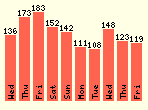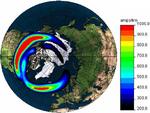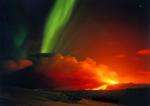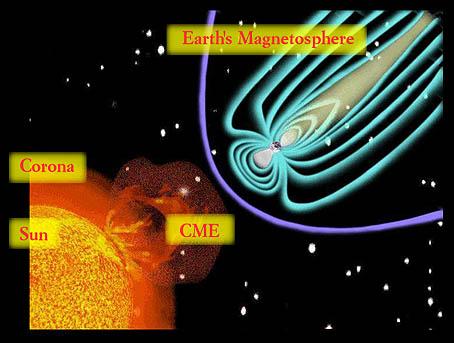Letecia lives in Ojai, where the time now is:
Unique Readers:

Recent Search Engine Searches:
Primarily
Public Domain
Everything I've written here is hereby placed in the public domain. The quotes from other people's writings, and the
pictures used might or might not be copyrighted, but are considered fair use. Thus the license here would best be
described as:
Primarily Public Domain.
|
Syndication:

![Validate my RSS feed [Valid RSS]](http://www.worldtrans.org/pic/valid-rss.png)
WebLog Resources:
NCN NewsLogs
Weblogs.com
blo.gs
Technorati
Organica
DayPop
Blogdex
PopDex
Blogging Ecosystem
BlogTree
BlogStreet
BlogWise
BlogChalking
Wander-Lust
|
| Thursday, September 25, 2003 |  |
|
|
|
 25 Sep 2003 @ 10:06 25 Sep 2003 @ 10:06
Propulsion Laboratory September 21, 2003
The Galileo spacecraft's 14-year odyssey came to an end on Sunday, Sept. 21, when the spacecraft passed into Jupiter's shadow then disintegrated in the planet's dense atmosphere at 11:57 a.m. Pacific Daylight Time. The Deep Space Network tracking station in Goldstone, Calif., received the last signal at 12:43:14 PDT. The delay is due to the time it takes for the signal to travel to Earth.
Hundreds of former Galileo project members and their families were present at NASA's Jet Propulsion Laboratory in Pasadena, Calif., for a celebration to bid the spacecraft goodbye.
"We learned mind-boggling things. This mission was worth its weight in gold," said Dr. Claudia Alexander, Galileo project manager.
Having traveled approximately 4.6 billion kilometers (about 2.8 billion miles), the hardy spacecraft endured more than four times the cumulative dose of harmful jovian radiation it was designed to withstand. During a previous flyby of the moon Amalthea in November 2002, flashes of light were seen by the star scanner that indicated the presence of rocky debris circling Jupiter in the vicinity of the small moon. Another measurement of this area was taken today during Galileo's final pass. Further analysis may help confirm or constrain the existence of a ring at Amalthea's orbit.
"We haven't lost a spacecraft, we've gained a steppingstone into the future of space exploration," said Dr. Torrance Johnson, Galileo project scientist.
The spacecraft was purposely put on a collision course with Jupiter because the onboard propellant was nearly depleted and to eliminate any chance of an unwanted impact between the spacecraft and Jupiter's moon Europa, which Galileo discovered is likely to have a subsurface ocean. Without propellant, the spacecraft would not be able to point its antenna toward Earth or adjust its trajectory, so controlling the spacecraft would no longer be possible. The possibility of life existing on Europa is so compelling and has raised so many unanswered questions that it is prompting plans for future spacecraft to return to the icy moon.
Galileo was launched from the cargo bay of Space Shuttle Atlantis in 1989. The exciting list of discoveries started even before Galileo got a glimpse of Jupiter. As it crossed the asteroid belt in October 1991, Galileo snapped images of Gaspra, returning the first ever close-up image of an asteroid. Less then a year later, the spacecraft got up close to yet another asteroid, Ida, revealing it had its own little "moon," Dactyl, the first known moon of an asteroid. In 1994 the spacecraft made the only direct observation of a comet impacting a planet-- comet Shoemaker-Levy 9's collision with Jupiter.
The descent probe made the first in-place studies of the planet's clouds and winds, and it furthered scientists' understanding of how Jupiter evolved. The probe also made composition measurements designed to assess the degree of evolution of Jupiter compared to the Sun.
Galileo made the first observation of ammonia clouds in another planet's atmosphere. It also observed numerous large thunderstorms on Jupiter many times larger than those on Earth, with lightning strikes up to 1,000 times more powerful than on Earth. It was the first spacecraft to dwell in a giant planet's magnetosphere long enough to identify its global structure and to investigate the dynamics of Jupiter's magnetic field. Galileo determined that Jupiter's ring system is formed by dust kicked up as interplanetary meteoroids smash into the planet's four small inner moons. Galileo data showed that Jupiter's outermost ring is actually two rings, one embedded within the other.
Galileo extensively investigated the geologic diversity of Jupiter's four largest moons: Ganymede, Callisto, Io and Europa. Galileo found that Io's extensive volcanic activity is 100 times greater than that found on Earth. The moon Europa, Galileo unveiled, could be hiding a salty ocean up to 100 kilometers (62 miles) deep underneath its frozen surface containing about twice as much water as all the Earth's oceans. Data also showed Ganymede and Callisto may have a liquid-saltwater layer. The biggest discovery surrounding Ganymede was the presence of a magnetic field. No other moon of any planet is known to have one.
The prime mission ended six years ago, after two years of orbiting Jupiter. NASA extended the mission three times to continue taking advantage of Galileo's unique capabilities for accomplishing valuable science. The mission was possible because it drew its power from two long-lasting radioisotope thermoelectric generators provided by the Department of Energy.
"The mission was a testimonial to the persistence of NASA even through tremendous challenges. It was a phenomenal mission," said Sean O'Keefe, NASA administrator.
JPL, a division of the California Institute of Technology in Pasadena, manages the Galileo mission for NASA's Office of Space Science, Washington, D.C. JPL designed and built the Galileo orbiter, and operated the mission.
Additional information about the Galileo mission and its discoveries is available online or here
Check here for information about NASA
|
|
| Thursday, July 17, 2003 |  |
|
|
|
 17 Jul 2003 @ 08:43 17 Jul 2003 @ 08:43
Issued: 2003 Jul 16 1227 UTC :Product: documentation here
Continued disturbed solar wind conditions have boosted geomagnetic activity to major storm levels (Kp=6). In the coming hours we expect a return to more moderate activity (Kp=3-4). Meanwhile flaring activity on the Sun has dropped below the C-flare level.
|
|
| Tuesday, July 15, 2003 |  |
|
|
|
 15 Jul 2003 @ 11:32 15 Jul 2003 @ 11:32
:Issued: 2003 Jul 15 0743 UTC :Product: documentation here
Since midnight, a minor geomagnetic storm (Kp=5) is ongoing.
This storm was predicted and is the consequence of an increasing solar wind speed from a coronal hole approaching a favourable position on the solar disc. A sudden southward turning of the magnetic field in the solar wind around 22h00 UT Jul 14 triggered the beginning of the storm.
We expect a slow decay (< 1 day) of the present disturbed geomagnetic conditions.
|
|
|
|
 15 Jul 2003 @ 10:37 15 Jul 2003 @ 10:37
Ran across this picture and wondered what star system was birthing here.
|
|
| Saturday, July 12, 2003 |  |
|
|
|
 12 Jul 2003 @ 14:56 12 Jul 2003 @ 14:56
Jeff Gordon from another New Civilization Network, keeps me posted on solar flare activity - Thanks Jeff!
Issued: 2003 Jul 12 0733 UTC :Product: documentationhere
FAST WARNING 'PRESTO' MESSAGE from the SIDC (RWC-Belgium)
Minor storm geomagnetic conditions are currently recorded due to high speed coronal hole stream effects (Izmiran: Kp=6), the conditions was active since yesterday midday.
Monday 14 th may see further elevated conditions due to the M3.6 x-ray flare that occurred on 10 July.
Let me know if you notice anything unusal happening on Monday, mood swings, irrtibility, over stressed, sleepy, unable to sleep, etc.
|
|
| Friday, March 28, 2003 |  |
|
|
|
 28 Mar 2003 @ 22:05 28 Mar 2003 @ 22:05
For the last several years I have been facinated by sun spots solar flare activity and geomagnetic storms. Many thanks to Jeff Gordon from NCN and The Well Now Project, who introduced me to these celestial happenings. He has a link on his site for Today's Space Weather which I found really informative and useful.
Here are some solar effects
Solar Cycles
The Sun goes through cycles of high and low activity that repeat approximately every 11 years. The number of dark spots on the Sun (sunspots) marks this variation; as the number of sunspots increases, so does solar activity. Sunspots are sources of flares, the most violent events in the solar system. In a matter of minutes, a large flare releases a million times more energy than the largest earthquake.
Solar-Terrestrial Effects
Episodic solar activity has a number of effects that are of interest to us. A radiation dose from energetic particles is an occasional hazard for astronauts and for electronics on satellites. Geomagnetic field disturbances may damage power systems, disrupt communications, degrade high-tech navigation systems, or create the spectacular aurora (Northern and Southern lights). SEC provides warnings of these events and continues the solar monitoring that began 400 years ago with Galileo's invention of the telescope.
Earth-Space Activities
... disrupted by solar and geomagnetic events
Satellite operations
Navigation
Space Shuttle and Space Station activities
High-altitude polar flights
Electric power distribution
Long-line telephone communication
HF radio communication
Pipeline operations
Geophysical exploration
Solar Flare Characteristics
Solar flares are tremendous explosions on the surface of the Sun. In a matter of just a few minutes they heat material to many millions of degrees and release as much energy as a billion megatons of TNT. They occur near sunspots, usually along the dividing line (neutral line) between areas of oppositely directed magnetic fields.
Flares release energy in many forms - electro-magnetic (Gamma rays and X-rays), energetic particles (protons and electrons), and mass flows. Flares are characterized by their brightness in X-rays (X-Ray flux). The biggest flares are X-Class flares. M-Class flares have a tenth the energy and C-Class flares have a tenth of the X-ray flux seen in M-Class flares. The National Oceanic and Atmospheric Administration (NOAA) monitors the X-Ray flux from the Sun with detectors on some of its satellites.
Ok, so if we have an active sun spot with a coronal mass ejection we get a Geomagnetic Storm
One to four days after a flare or eruptive prominence occurs, a slower cloud of solar material and magnetic fields reaches Earth, buffeting the magnetosphere and resulting in a geomagnetic storm. These storms are extraordinary variations in Earth's surface magnetic field. During a geomagnetic storm, portions of the solar wind's energy is transferred to the magnetosphere, causing Earth's magnetic field to change rapidly in direction and intensity and energize the particle populations within it.
We are part of the "particle population" on planet Earth, few of us have mastered the "wave aspect". Jeff and a few others members of NCN have been tracking these events and how the translate in our personal lives over the last several years. It seems that we each respond to the events in different ways, some need more sleep, some are all charged up - energized in a good way, some are aggitated or angry, tense or stressed out.
A Primer on Space Weather tells us:
There is a growing body of evidence that changes in the geomagnetic field affect biological systems. Studies indicate that physically stressed human biological systems may respond to fluctuations in the geomagnetic field. Interest and concern in this subject have led the Union of Radio Science International to create a new commission entitled Electromagnetics in Biology and Medicine.
Possibly the most closely studied of the variable Sun's biological effects has been the degradation of homing pigeons' navigational abilities during geomagnetic storms. Pigeons and other migratory animals, such as dolphins and whales, have internal biological compasses composed of the mineral magnetite wrapped in bundles of nerve cells. While this probably is not their primarily method of navigation, there have been many pigeon race smashes, a term used when only a small percentage of birds return home from a release site. Because these losses have occurred during geomagnetic storms, pigeon handlers have learned to ask for geomagnetic alerts and warnings as an aid to scheduling races.
And ends by saying:
It has been realized and appreciated only in the last few decades that solar flares, CMEs, and magnetic storms affect people and their activities. The list of consequences grows in proportion to our dependence on technological systems. The subtleties of the interactions between Sun and Earth, and between solar particles and delicate instruments, have become factors that affect our well being. Thus there will be continued and intensified need for space environment services to address health, safety, and commercial needs.
Until I read this primer today, I had an intuitive sense that we were being affected by these solar activites. The pressure seems to build, with some of the people I know feeling a hightened sense of anxiety, pressure even prior to an event and some immediately afterward and some still do not feel the anything until the wave of particles hit our planet. We try to make meaning of all of this additional 'feeling', find the reason for why we are feeling the way we do. Maybe it is just a solar flare and not your partner's behavior afterall! The jury is still on how we are being influenced/affected, though more evidence shows that solar activity does affect us some how.
It's spring! Ride the energy waves...
|
|
| Friday, March 14, 2003 |  |
|
|
|
 14 Mar 2003 @ 18:23 14 Mar 2003 @ 18:23
This is not science fiction, this is real! An article in New Science by Duncan Graham-Rowe talks about "the world's first brain prosthesis -- an artificial hippocampus" which is about to be tested in California.
"The job of the hippocampus appears to be to "encode" experiences so they can be stored as long-term memories elsewhere in the brain. "If you lose your hippocampus you only lose the ability to store new memories," says Berger. That offers a relatively simple and safe way to test the device: if someone with the prosthesis regains the ability to store new memories, then it's safe to assume it works.
Good to know that soon, any damaged parts of my brain can be replaced.
|
|
<< Newer entries Page: 1 2 |
|

